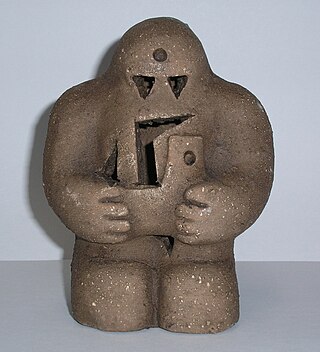
A golem is an animated, anthropomorphic being in Jewish folklore, which is entirely created from inanimate matter, usually clay or mud. The most famous golem narrative involves Judah Loew ben Bezalel, the late 16th-century rabbi of Prague. According to Moment magazine, "the golem is a highly mutable metaphor with seemingly limitless symbolism. It can be a victim or villain, man or woman—or sometimes both. Over the centuries, it has been used to connote war, community, isolation, hope, and despair."

Gustav Meyrink was the pseudonym of Gustav Meyer, an Austrian author, novelist, dramatist, translator, and banker, most famous for his novel The Golem. He has been described as the "most respected German language writer in the field of supernatural fiction".

Judah Loew ben Bezalel, also known as Rabbi Loew, the Maharal of Prague, or simply the Maharal, was an important Talmudic scholar, Jewish mystic, mathematician, astronomer, and philosopher who, for most of his life, served as a leading rabbi in the cities of Mikulov in Moravia and Prague in Bohemia.

Josefov is a town quarter and the smallest cadastral area of Prague, Czech Republic, formerly the Jewish ghetto of the town. It is surrounded by the Old Town. The quarter is often represented by the flag of Prague's Jewish community, a yellow Magen David on a red field.

The Old New Synagogue, also called the Altneuschul, situated in Josefov, Prague, is Europe's oldest active synagogue. It is also the oldest surviving medieval synagogue of twin-nave design.
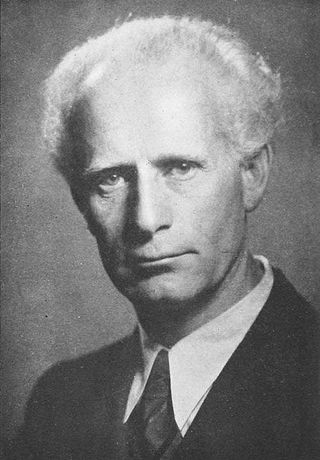
H. Leivick was a Yiddish language writer, known for his 1921 "dramatic poem in eight scenes" The Golem. He also wrote many highly political, realistic plays, including Shop. He adopted the pen name of Leivick to avoid being confused with Moyshe-Leyb Halpern, another prominent Yiddish poet.
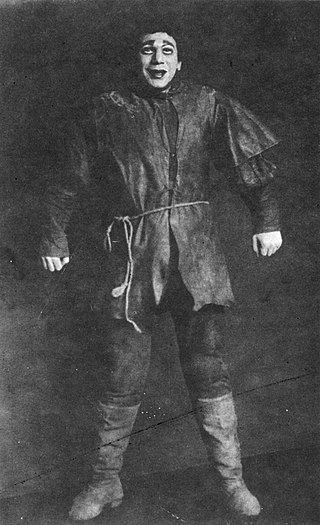
The Golem is a 1921 "dramatic poem in eight scenes" by H. Leivick. The story is a reworking of a legend of Judah Loew ben Bezalel, known as the Maharal, a great rabbi of Prague. In the legend, he animates a golem, a being crafted from inanimate material. The same legends had provided the ground for Gustav Meyrink's 1915 novel of the same name.
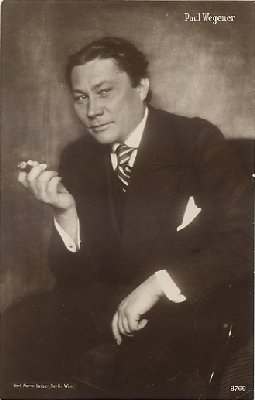
Paul Wegener was a German actor, writer, and film director known for his pioneering role in German expressionist cinema.
Der Golem is a partially lost 1915 German silent horror film written and directed by Paul Wegener and Henrik Galeen. It was inspired by a Jewish folktale, the most prevalent version of the story involving 16th century Rabbi Judah Loew ben Bezalel who created the Golem to protect his people from antisemites. Wegener claimed the film was based on Gustav Meyrink's 1915 novel The Golem, but, as the movie has little to do with existing Jewish traditions, Troy Howarth states "it is more likely that simply drew upon European folklore".
A golem is an artificial animated being in medieval and Jewish folklore.
Elijah bar Aaron Judah Baal Shem was a Polish rabbi and kabbalist who served as chief rabbi of Chełm. One of the most eminent Talmudists of his generation, he is recorded as the first person known by the epithet "Ba'al Shem" having been considered a great saint and believed to have used miraculous powers to create a golem.

The Golem: How He Came into the World is a 1920 German silent horror film and a leading example of early German Expressionism. Director Paul Wegener, who co-directed the film with Carl Boese and co-wrote the script with Henrik Galeen based on Gustav Meyrink's 1915 novel, stars as the titular creature, a being in Jewish folklore created from clay. Photographer Karl Freund went on to work on the 1930s classic Universal horror films years later in Hollywood.
The Golem is the name of a number of fictional characters appearing in American comic books published by Marvel Comics. These include:
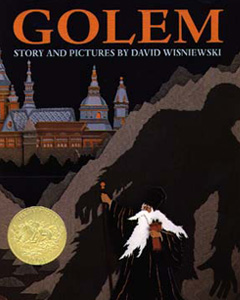
Golem is a 1996 picture book written and illustrated by David Wisniewski. With illustrations made of cut-paper collages, it is Wisniewski's retelling of the Jewish folktale of the Golem with a one-page background at the end.

The history of the Jews in the Czech lands, historically the Lands of the Bohemian Crown, including the modern Czech Republic, goes back many centuries. There is evidence that Jews have lived in Moravia and Bohemia since as early as the 10th century. Jewish communities flourished here specifically in the 16th and 17th centuries, and again in the late 19th and early 20th centuries. Local Jews were mostly murdered in the Holocaust, or exiled at various points. As of 2021, there were only about 2,300 Jews estimated to be living in the Czech Republic.

Le Golem is a 1936 Czechoslovak monster movie directed by Julien Duvivier in French language.
Practical Kabbalah in historical Judaism, is a branch of the Jewish mystical tradition that concerns the use of magic. It was considered permitted white magic by its practitioners, reserved for the elite, who could separate its spiritual source from qlippoth realms of evil if performed under circumstances that were holy (Q-D-Š) and pure, tumah and taharah. The concern of overstepping Judaism's strong prohibitions of impure magic ensured it remained a minor tradition in Jewish history. Its teachings include the use of Divine and angelic names for amulets and incantations.

Tarłów is a village in Opatów County, Świętokrzyskie Voivodeship, in south-central Poland. It is the seat of the gmina called Gmina Tarłów. It lies approximately 30 kilometres (19 mi) north-east of Opatów and 79 km (49 mi) east of the regional capital Kielce. It is approximately 13 kilometres (8 mi) north of the town of Ozarow. The village belongs to historic province of Lesser Poland.
Pérák: The Shadow over Prague is a 2016 Czech animated superhero film, which premiered on 20 June 2016. It was inspired by an urban legend about Pérák, the Spring Man of Prague, by Rychlé šípy and the legend of the Golem of Prague. Director Marek Berger has said that he intends to make sequels.
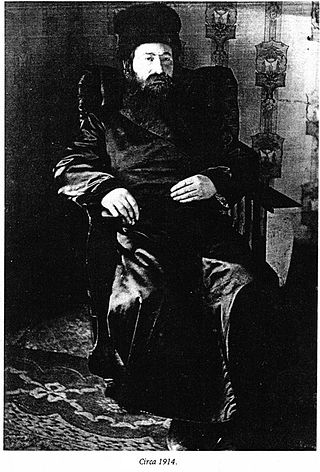
Yehudah Yudel Rosenberg was a rabbi, author, and Jewish communal leader in Poland and Canada. He is best known for his Hebrew translation of the Zohar, and for popularizing the tale of the Golem of Prague.














